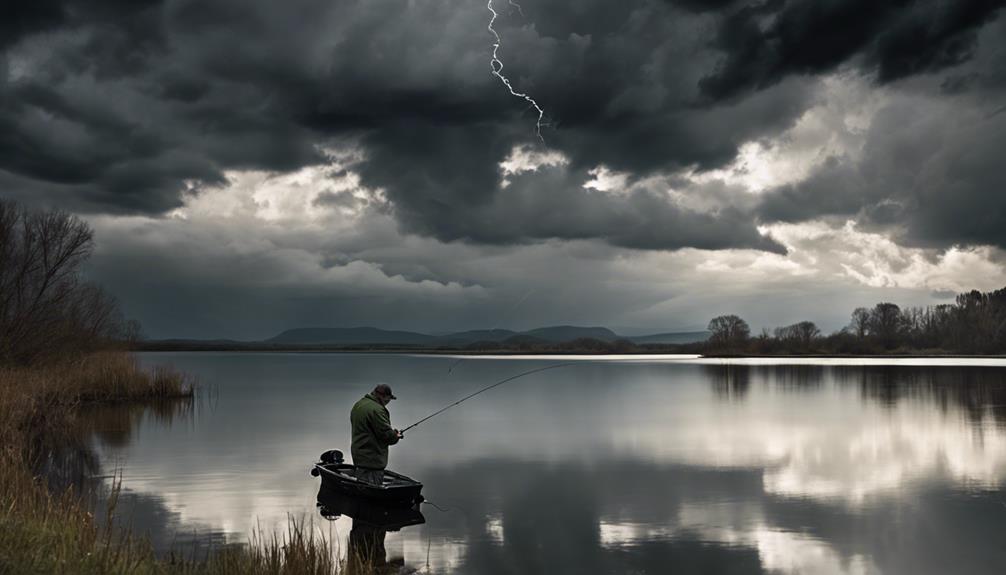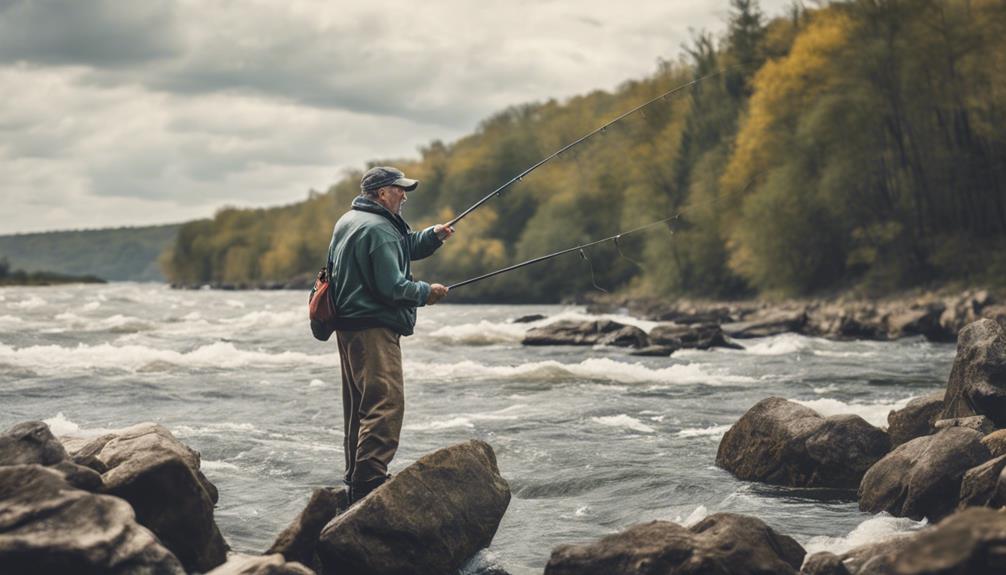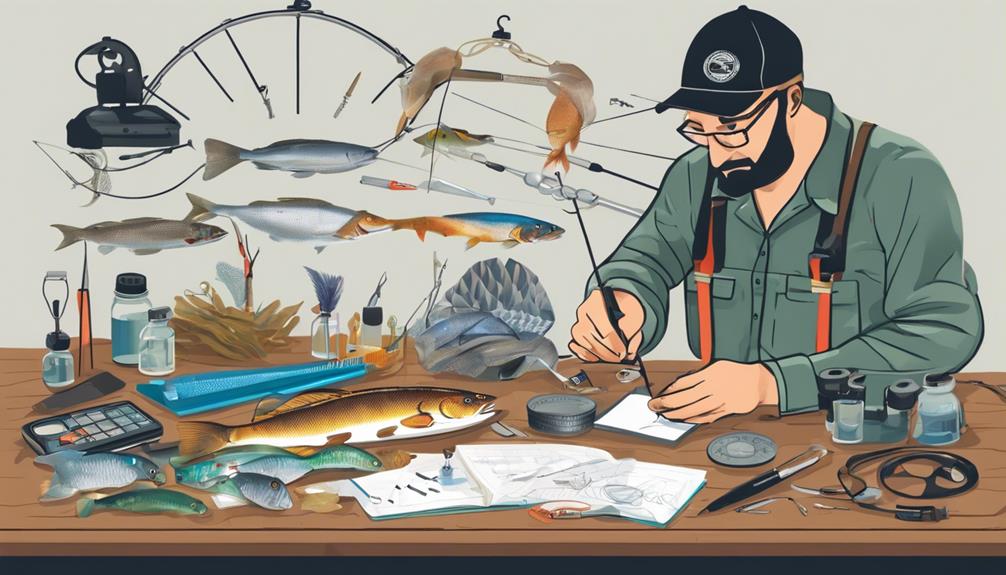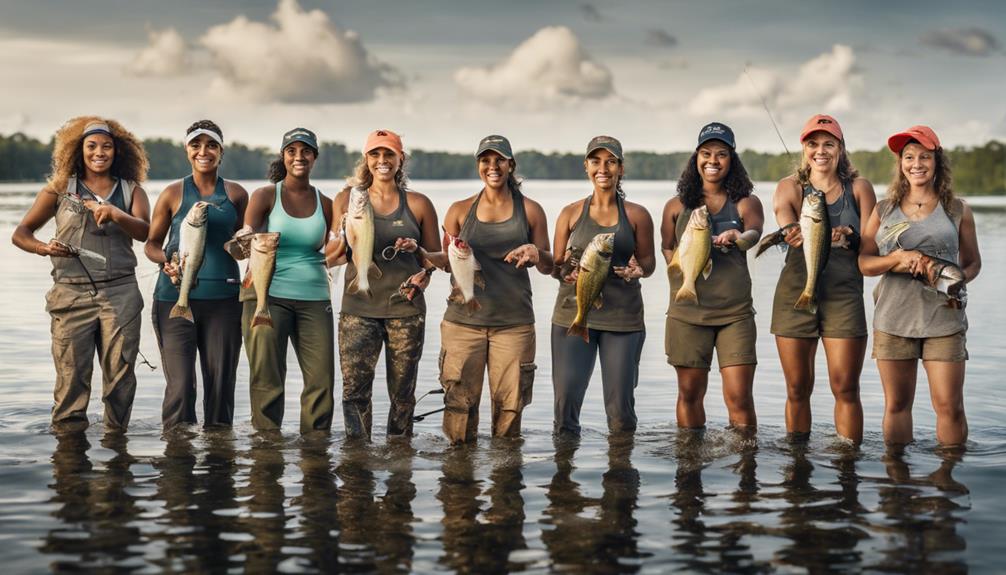Have you ever considered how much of an impact weather conditions can have on your angling success?
The role of weather in competitive fishing goes beyond just a sunny day or a rainy afternoon. Understanding how temperature, wind, barometric pressure, cloud cover, and other weather elements influence fish behavior can be the key to unlocking consistent success on the water.
By exploring these factors in more detail, you may just uncover the missing piece to elevate your angling game to the next level.
Understanding Weather Patterns
To better predict fishing conditions, familiarize yourself with prevailing weather patterns in your angling area. Weather forecasting techniques play a crucial role in determining the optimal conditions for a successful fishing trip. By keeping track of weather patterns, you can increase your chances of a fruitful angling experience. Understanding how specific weather conditions impact fish behavior is key to adapting your fishing strategies accordingly.
Fishing success correlations are often linked to weather patterns. For example, knowing how changes in barometric pressure affect fish activity can help you plan your outings more effectively. Weather tracking tools like apps and websites can provide real-time updates on temperature, wind speed, and precipitation, allowing you to make informed decisions about when and where to fish.
Climate change implications are also important to consider when analyzing weather patterns. As global temperatures rise, fish habitats and migration patterns may shift, impacting the availability and behavior of different species. By staying informed about climate trends, you can better anticipate these changes and adjust your angling techniques accordingly.
Impact of Temperature Variations
Temperature variations directly influence the behavior and feeding habits of fish in your angling area. Water temperature impacts fish behavior significantly. As temperatures fluctuate, fish may move to different depths in search of their preferred water temperature. Understanding thermocline depths, where there's a rapid change in water temperature with depth, is crucial. During warmer months, fish tend to seek cooler waters below the thermocline, while in colder months, they may stay above it.
These temperature changes also impact bait selection. Fish are more active and likely to feed in waters where the temperature matches their preferred range. In warmer conditions, fish may be more aggressive and willing to strike at faster-moving baits. Conversely, in colder temperatures, fish may be less active and more selective in their feeding habits, requiring slower presentations and smaller, more natural-looking baits.
To adapt to these temperature variations, it's essential to monitor water temperatures in different parts of the angling area. Using tools like fish finders with temperature sensors can help you locate fish at their preferred temperature zones. By adjusting your bait selection and presentation based on the current water temperature, you can increase your chances of a successful catch. Understanding the impact of temperature on fish behavior is key to optimizing your angling strategy for different weather conditions.
Wind Speed and Direction Effects
Wind speed and direction play a crucial role in determining the success of your angling endeavors. When facing varying wind conditions, adjusting your tackle selection becomes paramount. Light winds allow for delicate presentations, making finesse baits like drop shots or wacky rigs effective. In contrast, on windy days, opt for heavier baits such as crankbaits or spinnerbaits that can withstand the choppy waters. Understanding how wind affects the water movement can help you anticipate where fish might be lurking.
Boat positioning is another aspect heavily influenced by wind speed and direction. When the wind is blowing parallel to the shore, position your boat to cast towards the bank. This strategy takes advantage of the current created by the wind, pushing baitfish towards the shoreline, enticing predatory fish to feed. On the other hand, when the wind is blowing towards the shore, position your boat to cast away from it. Fish often face into the current, so presenting your bait in the direction the fish are expecting it can lead to more bites.
Importance of Barometric Pressure
Understanding the barometric pressure's impact on fish behavior is key to enhancing your angling success. Barometric pressure, also known as atmospheric pressure, plays a significant role in influencing how fish behave and feed.
Here are some essential points to consider when it comes to barometric pressure and fishing:
- Pressure Systems: Fish are sensitive to changes in barometric pressure, with low-pressure systems often triggering increased feeding activity as the pressure drops. On the other hand, high-pressure systems can lead to decreased feeding behavior, making fishing more challenging.
- Behavioral Patterns: Pay attention to how fish react to different pressure conditions. Experiment with various fishing techniques to see how fish respond during changing barometric pressure situations.
- Adaptation is Key: Be prepared to adapt your fishing strategies based on the prevailing barometric pressure. Understanding how fish react to these changes can help you make informed decisions while on the water.
- Optimizing Fishing Techniques: Utilize fishing techniques that align with the current barometric pressure to maximize your chances of a successful catch. Experimenting with different lures, baits, and depths can help you find what works best under specific pressure conditions.
Cloud Cover and Lighting Conditions
Consider how cloud cover and lighting conditions directly impact fish behavior and your angling success. When it comes to shadow casting and fish behavior, cloud cover plays a crucial role. Clouds can create shadows in the water that mimic the appearance of predators to the fish below. This can trigger their predatory instincts, making them more likely to strike at your lure.
Moreover, the sun angle influenced by cloud cover affects lure presentation. Bright sunlight can make lures appear unnatural and overly bright, potentially spooking fish. On the other hand, when clouds diffuse sunlight, it creates a more subdued lighting condition that can make your lure look more natural and appealing to fish.
Understanding how cloud cover and lighting conditions impact fish behavior is essential for maximizing your angling success. On sunny days with minimal cloud cover, consider using lures that create subtle movements to avoid startling fish. When clouds obscure the sun, take advantage of the diffused lighting to present your lure in a more natural and enticing manner.
Rainfall and Water Clarity
When fishing, pay attention to how rainfall affects water clarity as it can significantly impact your angling success. Rainfall can have a profound effect on the conditions of the water you're fishing in, influencing the behavior of the fish and requiring you to adjust your fishing techniques accordingly.
- Runoff Effects: After heavy rainfall, runoff from the surrounding land can carry sediment, debris, and nutrients into the water, affecting visibility and oxygen levels. Fish may become more sluggish or move to different areas in response to these changes.
- Sediment Dispersion: Increased sediment in the water can reduce visibility, making it harder for fish to see your lures. In such conditions, consider using brighter or noisier lures to attract fish effectively.
- Fishing Techniques: During periods of high water turbidity caused by rainfall, try using techniques like bottom bouncing or slow retrieves to target fish that rely more on their sense of smell or vibration to locate prey.
- Lure Selection: Opt for lures that create more vibration or have rattles to compensate for reduced visibility. Additionally, choosing lures with contrasting colors or larger profiles can help them stand out in murky water, improving your chances of enticing a bite.
Being mindful of how rainfall affects water clarity and adapting your fishing strategies accordingly can make a significant difference in your angling success.
Seasonal Weather Considerations

Incorporate seasonal weather patterns into your angling strategy to maximize your chances of success. Understanding how different seasons affect fish behavior is crucial. During the summer, fish tend to go deeper to find cooler waters, so adjust your gear selection accordingly. Use heavier lures or sinkers to reach them in deeper waters. In contrast, during the spring and fall, fish are more active near the surface, so lighter gear can work well.
Timing bites is essential when considering seasonal weather patterns. In the winter, for example, fish are more sluggish and may not bite as readily. Therefore, patience is key during this season. Focus on slower presentations and be prepared to wait longer for bites. In the warmer months, early morning and late evening are prime times for fishing as fish are more active during these cooler parts of the day.
Consider the impact of weather changes on fish behavior. For instance, in the spring, sudden rain can lead to increased runoff into the water, affecting visibility. Be ready to adapt by using brighter lures or adjusting your fishing location. By being mindful of seasonal weather patterns and adjusting your gear selection and bite timing accordingly, you can increase your chances of a successful day on the water.
Adapting Strategies to Weather Changes
Wondering how to adjust your angling strategy in response to changing weather conditions? When the weather shifts, it's essential to adapt your approach to maximize your chances of a successful fishing trip. Here are some key tips to help you fine-tune your strategy:
- Tackle Selection: One of the most crucial aspects of adapting to changing weather conditions is choosing the right tackle. Different weather patterns may require different types of lures, baits, or lines. For example, on windy days, you might opt for heavier lures that can cut through the air more effectively.
- Technique Adjustments: Weather changes often call for modifications in your fishing techniques. If the temperature drops suddenly, fish may move to deeper waters, prompting you to adjust your casting depth. Similarly, during rainy days, fish may seek shelter under structures, leading you to focus your casts around such areas.
- Stay Flexible: Remain open to changing your strategy on the fly as weather conditions evolve throughout the day. Being adaptable and willing to experiment with different approaches can significantly improve your chances of a successful catch.
- Monitor Weather Reports: Keep a close eye on weather forecasts before heading out. This will help you anticipate any upcoming changes and prepare accordingly, ensuring you're equipped to adjust your strategy as needed.
Frequently Asked Questions
How Do Weather Patterns Differ Between Freshwater and Saltwater Fishing Environments?
When you're out fishing, weather patterns can vary between freshwater and saltwater environments. In freshwater, you might notice more stable conditions compared to the dynamic changes in saltwater.
Tidal influences play a big role in saltwater fishing, affecting where fish gather. Wind patterns can also differ, impacting angler preparation.
Understanding these differences helps you adjust your fishing strategies accordingly for a successful day on the water.
Can the Moon Phases Affect Fish Behavior in Relation to Weather Conditions?
When considering fish behavior, lunar cycles play a crucial role. The moon phases can influence how active fish are in response to weather conditions. Understanding these patterns can help you fine-tune your tournament strategies.
Are There Certain Types of Fish That Are More Affected by Changes in Barometric Pressure?
Certain types of fish are more affected by changes in barometric pressure. Different fish species have varying levels of sensitivity to fluctuations in barometric pressure, which can influence their behavior.
Some species like bass and trout are known to be particularly responsive to changes in barometric pressure, leading to shifts in their feeding patterns and activity levels.
Understanding these dynamics can help anglers strategize and improve their chances of a successful catch.
How Does Humidity Play a Role in Fish Activity and Feeding Patterns?
Humidity affects fish activity and feeding patterns by influencing the water temperature variations. When humidity is high, it can lead to warmer water temperatures, which may increase fish behavior and activity.
Additionally, high humidity levels are often associated with calm weather conditions, affecting wind speed and potentially altering fish feeding habits.
Monitoring humidity levels can provide valuable insights into optimizing your angling strategy based on fish behavior and environmental conditions.
Are There Any Specific Weather-Related Factors That Can Impact the Use of Certain Bait or Lures in Competitive Angling Tournaments?
When choosing your bait for competitive angling tournaments, weather impact is crucial. Different weather conditions can affect bait selection and lure choice.
Pay attention to factors like temperature, wind, and water clarity to determine the most effective bait or lure to use.
Adjust your strategy based on the specific weather conditions you encounter on tournament day to increase your chances of a successful catch.
Conclusion
As an angler, unlocking the role of weather in competitive fishing can make a huge difference in your success on the water. By understanding how temperature, wind, barometric pressure, cloud cover, rainfall, and seasonal changes impact fishing conditions, you can adapt your strategies accordingly.
So next time you head out to the water, remember to keep an eye on the weather forecast and adjust your approach to maximize your chances of landing that big catch.
Happy fishing!



